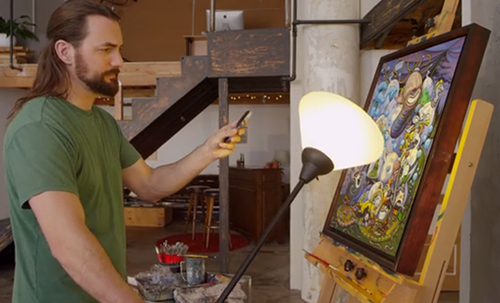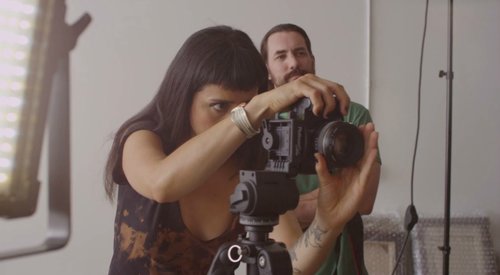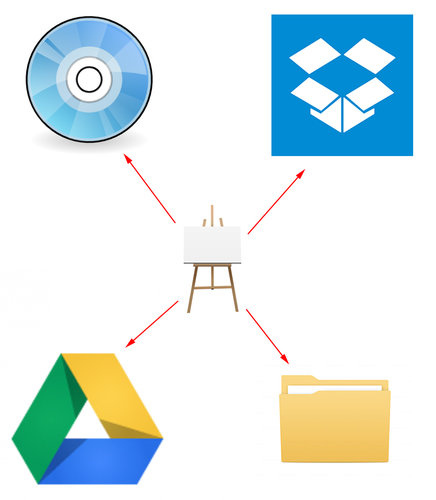by guest blogger Andy Derrick
Four reasons why your digital portfolio isn’t helping you the way it should.

Engaging effectively in the digital world is now more essential than ever to be a successful artist— and after countless conversations with artists I’ve found this is an area where nearly everybody struggles.
You want to spend your time creating, right? Not solving all the moving parts of getting quality images of your artwork, managing them well, and sharing them effectively. Focus on finding efficient solutions for the areas below where almost all artists fall short and you’ll clear up your time for creating AND sell more of your art.
Sourcing Images
It should go without saying— having quality digital images is 100% critical for your art business.
When promoting online, making prints, submitting to galleries, etc. not having images that reflect the quality of your original work is like showing up to an interview in a suit that’s dirty and wrinkled. No one would do that, but I talk with artists every day who have settled for poor image quality when it comes to their artwork without understanding what exactly that communicates.

Due to the high costs traditionally associated with professional digitization, most artists have ended up using DIY solutions like photographing with an iPhone or their own digital camera. Some seek out a photographer friend who more often than not has no experience photographing artwork. Others say “to heck with it” and avoid getting digital images of their work altogether.
For such an important part of your creative business it’s necessary to find a quality solution that delivers images with proper resolution, color, white-balance, alignment and cropping.
Storing Images
The second place artists struggle managing their digital portfolios is in their storage practices. It’s a pain!
It’s rare to find an artist who has an all-in-one storage solution for their artwork. The vast majority have their digital images in a chaotic mixture of desktop folders, Dropbox, external hard drives, and a CD buried at the bottom of a desk drawer.

How many times have you spent 20 minutes searching for a particular file, not had your hard drive with you when you needed it, or lost a CD with images of your artwork?
The best thing to do is find one place that allows you to effectively backup, organize, and share your images. Otherwise, you’re wasting time and opportunities with a disjointed system.
Prepping Images
Artists are using their images for tons of different purposes and nearly all of these purposes call for a different file size, format, and resolution. It’s a complicated beast and most artists will admit they don’t know how to prepare their images for all the different uses.
You certainly don’t want to send the same image file to a printer that you used to post on Instagram or your website. How many times have you sent an image to a printer to find out it isn’t printable because the resolution was not high-enough? Have you ever failed to post an image to your website because it was too large or the wrong dimension?
It’s important to have a clear plan in place for the images you need and in what size/format so you don’t spend hours trying to figure out how to turn a 100 MB TIFF file into a 400 KB JPEG.
Protecting Images
Online piracy is a very real, very big problem. On this issue, there are generally artists on two ends of the spectrum: those who recklessly post high-res images all over the internet and those who are afraid to share any images of their artwork at all. Both are mistakes.
Here is my advice: NEVER post high-res files of your artwork publicly on the internet. You must assume that if it can be downloaded, it will be. Your full resolution art files are your creative assets and you should protect them as such.
In the same breath— let go of your fear of engaging online. Don’t be afraid to share your artwork publicly. If you’re only posting small to medium resolution images of a particular artwork no one will be able to replicate it in a meaningful way. So get your images out there in as many avenues as possible, but be smart about it.
Everyone understands the internet gives us powerful tools to connect with potential fans and sell more art. However, artists who wish to harness these tools must be strategic in how they deal with their digital portfolios. Take the time upfront to learn how to handle these major issues and you’ll be ahead of the game and poised to get your art out in to the world.


Fabulous article, thank you.
May I ask what you consider to be a low or medium res image?
Thanks,
Jutta
what Jutta said
Jutta,
So glad you found the article helpful!
To answer your question– low-res would be something below 100 dpi/ppi, medium-res would be from 100-200 dpi/ppi, high-res 200+ dpi/ppi, and print quality is typically considered 250+ dpi/ppi.
Andy
Thanks Andy, I’ll be checking all my images now!!!
Jutta
Helpful article. Addressed a number of issues I need to deal with.